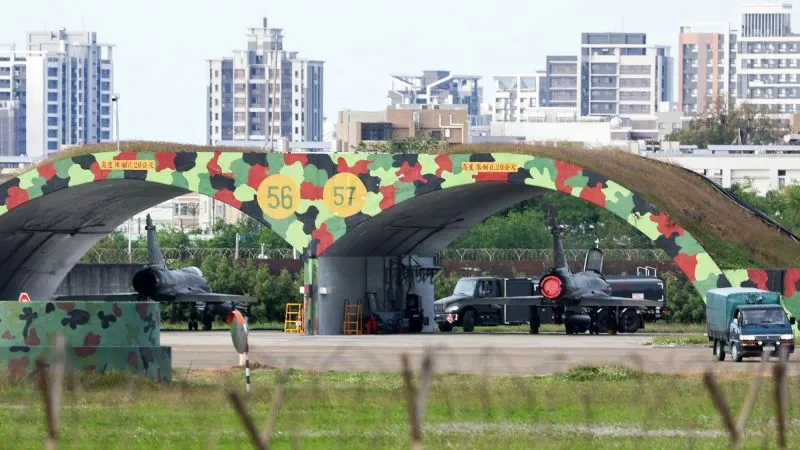
Tensions Escalate: China Intensifies Military Movements Around Taiwan Following Controversial Presidential Tour
2024-12-09
Author: Emily
Escalating Military Movements
In alarming developments, multiple formations of Chinese naval and coast guard vessels have been spotted maneuvering in the Taiwan Strait and surrounding Western Pacific waters, according to Taiwan’s Defense Ministry. This military mobilization suggests that Taiwan is bracing for potential military drills from Beijing amidst rising tensions.
Taiwan's armed forces reported the presence of vessels from the Chinese People’s Liberation Army (PLA) across various theater commands — Eastern, Northern, and Southern — indicating a significant show of force. This movement comes shortly after Taiwanese President Lai Ching-te ignited Beijing's anger with unofficial stops in Hawaii and Guam during his recent diplomatic tour of the South Pacific, which concluded last week.
Beijing's Response and Taiwan's Stance
Chinese officials have condemned Lai's travel, labeling him a “separatist” and expressing strong opposition, especially following the U.S. approval of new arms sales to Taiwan. China's ruling Communist Party has long regarded Taiwan as a part of its territory, despite never having controlled the island. Any official interactions between the U.S. and Taiwan are seen as affronts to China's sovereignty and have led to vows of “strong countermeasures” from Beijing.
Taiwan's leadership remains resolute against China's territorial claims and has consistently refused to be perceived as subordinate to Beijing. In light of the growing military presence, Taiwan’s Defense Ministry has initiated combat readiness exercises to counteract PLA activities and maintain high alert status.
Increased Naval Deployment
Sources reveal that China’s current naval deployment is larger than those during its previous military drills around Taiwan earlier this year. In May, China held extensive military drills, dubbing them “punishment” for perceived separatist actions after Lai took office, labeled “Joint Sword-2024A.” Similar drills, named “Joint Sword-2024B,” occurred in October following Lai’s assertions of Taiwan's independence during a National Day address.
However, the latest Chinese naval activities appear to focus on asserting control within the first island chain, which surrounds strategic regions including Japan and the Philippines, a shift from earlier encirclement tactics. Furthermore, the PLA has also established seven zones of airspace in proximity to Taiwan, indicating intensified air patrols intended to assert military presence.
International Reactions
In response to Taiwan's concerns about the military movements, Chinese Foreign Ministry spokesperson Mao Ning reiterated Beijing's stance, stating, “Taiwan is an integral part of China’s territory,” affirming that the Taiwan issue is strictly an internal Chinese matter.
During his tour, which included a visit to the Marshall Islands and other nations that maintain diplomatic ties with Taiwan, President Lai emphasized solidarity against authoritarian regimes. His address to the Taiwanese community in Guam resonated with calls for democratic resilience, as he encouraged nations to “never bow down to totalitarianism.” This tour marked Lai's first visit to the U.S. since assuming office, during which he engaged in discussions with prominent U.S. officials, including a phone call with House Speaker Mike Johnson.
Conclusion
As tensions simmer, Beijing has promised “resolute and strong measures” to safeguard its claims over Taiwan. The escalating military movements and the diplomatic rhetoric signal a potential flashpoint in the region, raising concerns about the stability and security of the Indo-Pacific landscape.
Will this geopolitical game of cat and mouse lead to further confrontation, or could diplomatic solutions emerge? The world watches closely as events unfold in this critical region.









 Brasil (PT)
Brasil (PT)
 Canada (EN)
Canada (EN)
 Chile (ES)
Chile (ES)
 España (ES)
España (ES)
 France (FR)
France (FR)
 Hong Kong (EN)
Hong Kong (EN)
 Italia (IT)
Italia (IT)
 日本 (JA)
日本 (JA)
 Magyarország (HU)
Magyarország (HU)
 Norge (NO)
Norge (NO)
 Polska (PL)
Polska (PL)
 Schweiz (DE)
Schweiz (DE)
 Singapore (EN)
Singapore (EN)
 Sverige (SV)
Sverige (SV)
 Suomi (FI)
Suomi (FI)
 Türkiye (TR)
Türkiye (TR)